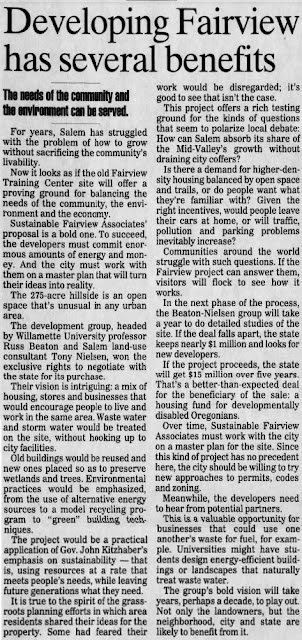With the City's press release about soliciting proposals on Block 50 downtown, the former site of the Union Gospel Mission, Saffron Supply, and the remnant first floor of the State Insurance Building, and with Fairview on the mind, it seemed interesting to look at how the Fairview concepts were first received about 20 years ago as the winning proposal took shape.
 |
| Block 50 (1892 Map of Salem, OHS) |
Recent projects downtown — Boise Cascade to South Block apartments, a gravel lot to the Nishioka Building, the Marion Car Park to New Holman Hotel, and the Nordstrom to apartments construction in progress — are meaningfully different from the redevelopment on former State institutions outside of downtown like the north campus of the State Hospital and Fairview. Mentioning "Block 50," then, is merely a prompt! I do not mean here to make any comparison or draw any comparative inferences.
 |
| January 16th, 2002 |
An early editorial from 2002 called the project a "proving ground" and "testing ground" for "balancing the needs of the community, the environment and the economy."
A news piece from 2003 talked about the "village center."
 |
| November 18th, 2003 |
From that piece:
Planners hope that an eclectic batch of businesses, from brew pubs to retail shops, will satisfy many of residents' daily needs. Eventually, opening of a local post office and a public school will help strengthen community ties....One goal of the project is to encourage residents to walk instead of drive their cars.A piece a few months earlier had talked about a "Main Street" running north and south. This seemed clearly to point to the older commercial main street form, and not any more generic sense of principal street.
Even before the Master Plan, people seemed to understand that there would be a commercial hub at the center of the Fairview project.
In 2004 another editorial explicitly framed it as "a sort of living laboratory." So the idea of it as a lab, testing ground, and case study was there from the start.
 |
| February 16th, 2004 |
By 2005, in a piece on the Master Plan, an observer offered some skepticism on the record.
 |
| April 24th, 2005 |
A real estate agent said
her main concern is that market forces will make the developers scale back their grand plans, resulting in mediocrity.And here we are nearly 20 years later.
With the paper clearly thinking of the project as a lab and testing ground, and with our current interests in neighborhood hubs, in new swaths of mix-use zoning with Our Salem, in new designations for Climate Friendly Areas, the City should ask more seriously, "What did we learn at Fairview?"
If we truly want certain outcomes as part of our response to the climate emergency, and for livability and for safety, it is not enough to throw up our hands and say "market forces" in a kind of determinism or fatalism. We should be more interested in what additional policy support might be necessary to achieve those outcomes. Important kinds of course-correction may be necessary. Even with new zoning, "more of the same" is likely not enough.
 |
| From last night's Work Session |
It is reasonable to want the City to be interested in a closer analysis. Our Salem could depend on it.


No comments:
Post a Comment